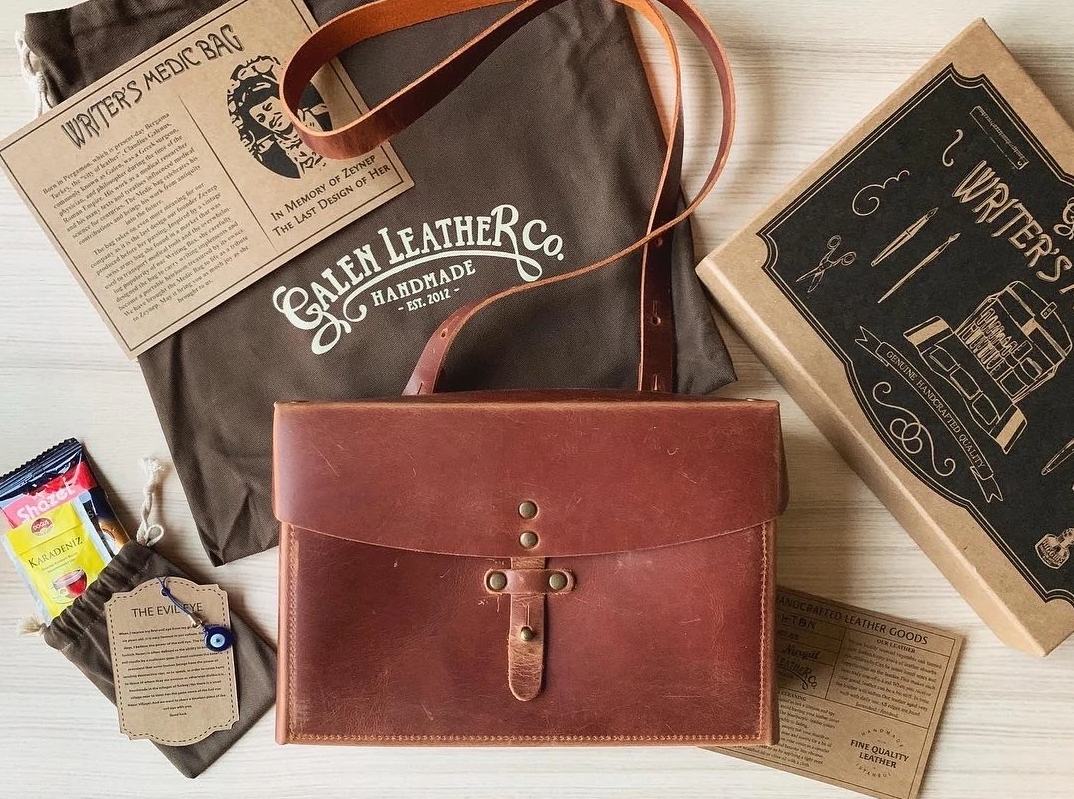
YouTube is Our Highest-Converting Channel Thanks to Micro-Influencers: Here’s Our Strategy
Learn how the Galan Leather co-founder has used an ongoing micro-influencer strategy to grow his small brand.
Co-founder of Galen Leather Co.
My company, Galen Leather Co., sells a fairly niche product: handmade leather and wood writing accessories, plus other craft goods that writing and stationery enthusiasts will appreciate. Because of that, we’ve found that the most effective way to market to our audience is via very niche channels: specifically, micro-influencers on YouTube.
Given our products’ aesthetic appeal, you may think Instagram would be the way to go. While we do have a fairly engaged Instagram following and sometimes work with influencers there, visitors from YouTube had a 28 percent higher conversion rate compared to those from Instagram in 2023.
YouTube influencers have been more impactful for our marketing for a couple of reasons. For one, the length of YouTube videos allows content creators to film a full experience of our products: to do an unboxing and show our thoughtful packaging, to highlight various ways to use our products on different desk setups, and to discuss the quality of the craftsmanship.
Plus, whereas content on most social channels is fairly temporary, YouTube videos can have lasting effects. We have videos that influencers made about our products years ago that still drive significant traffic today.
We’ve spent seven years fine-tuning our YouTube micro-influencer strategy. Thanks to that commitment, we now get over 20,000 visitors from YouTube each year. And at relatively little cost to the business given we only work with creators who are excited to post in exchange for free products rather than charging us a fee. Our marketing budget for this approach ends up just being time, free product, and shipping costs.
Read on to learn exactly how we find the right influencers to work with and structure our partnerships for maximum benefit to our small business.
We focus on content and engagement over follower count
Over time, we’ve honed in on an approach for identifying the influencers who will be most beneficial for our brand.
First, we make sure these creators are aligned with our niche so that we know they are speaking to our target audience. In the past, we’ve worked with topic-adjacent influencers, like accounts that review other types of leather goods, and found that those partnerships were unsuccessful.
Now, we start by going on YouTube and searching the sorts of keywords our ideal audience might use: planner setup, notebook reviews, bullet journaling, etc.
When we spot a potential new creator to work with, we don’t dig into their audience metrics right away — we start by watching their content. Are their videos eye-catching, informational, and high-quality? Do they seem to have a real passion for this niche and create authentic content? (We actually avoid influencers with too much advertising because that can degrade trust with their audience.)
Finally, we look at their audience metrics, but maybe not the numbers you’d think. We don’t pay too much attention to audience size because we’ve worked with folks who have large follower counts only to find their videos don’t receive many views.
Now, we focus more on engagement. Most of our partners have several hundred to several thousand followers, but each of their videos gets a high number of views (often even higher than their follower count!) and, perhaps more importantly, has a vibrant comments section, showing their audience is paying attention and cares about what they have to say.
We don’t require these influencers to only share positively
When reaching out to influencers about partnering, we don’t have extensive requirements about the type of content they need to create about our products.
For one, we aren’t paying for these partnerships. As a small company, we simply can’t afford the fees many creators ask for sponsorships, so instead we offer to send a free product. We want this to feel like a bonus for their channel, not a burden, so try not to be too demanding about our expectations. I always explain the benefits of our products in my pitch email so they can understand why this would be exciting content for their audience, like so:
Hi [insert name],
Allow me to introduce myself—I am Yusuf Perens, co-owner of Galen Leather, a family company known for crafting exquisite handmade leather goods. I recently just stumbled on your YouTube channel and thought it would be a great fit for a collaboration with Galen Leather given your passion for quality stationery.
I understand your inbox probably gets flooded with similar emails, so I will keep this brief.
Would you be interested in receiving one of our handmade leather notebooks, pen cases, fountain pens or another item to review or include in one of your videos? All of our products are handmade in Turkey using traditional leather and wood making techniques.
We love working with YouTubers who respect craftsmanship of unique products like ours. Unfortunately, with the cheap, mass factory production of similar items these days, it is becoming a rare trade in Turkey but our hope is to see the craft live on.
You can check out the full product range and learn more about our story here: https://www.galenleather.com
If this sounds of interest to you, please hit reply to this email so we can talk further about the next steps. We'd love to send you a product of your choosing if you're interested in working with us. Look forward to hearing back from you!
En iyi dileklerimle (Best wishes),
Yusuf
But, perhaps more importantly, not providing too many guidelines allows for more authentic and relatable content. We don’t want these review videos to feel like scripted sales pitches — in fact, we love it when the creators we work with talk about the pros and cons of our products.
Think about it: If a product online only has positive reviews, it can seem unbelievable. It’s much more authentic when someone shares feedback like, “This product is beautiful, but the size is a little small, so if you prefer larger sizes, you should look for a different product” or “I can tell the craftsmanship is wonderful, but distressed leather like this is not my style.”
Allowing the influencers we work with to review our products honestly increases trust with viewers and has decreased product return rates because customers truly understand whether our products meet their preferences or not. Plus, we’ve been able to take some of this constructive feedback, improve our product, and send the influencers an updated version. Some have even created comparison videos showing off the new and improved product, which ended up being incredibly successful content for the brand.
We focus on long-term wins instead of each individual campaign
For YouTube micro-influencer marketing to be successful, it has to be a long-term strategy, and you have to focus on long-term, compounding results.
Every month for the past seven years, we’ve reached out to a dozen micro-influencers about partnering, and about half typically say yes. Sometimes, the videos get us results right away. More often, they take a while to gain search traction, or they continue to gain views over the years as the creator grows their channel. Instead of obsessing about trying to measure the impact of each video, we pay more attention to the overall benefits, both qualitative and quantitative.
For example, yes, we have good conversion rates from YouTube and have seen those numbers grow over the years: The conversion rate for purchases made by visitors coming from YouTube has increased by 31 percent from 2019 to 2023. But I also know that increasing the amount of content about our brand on YouTube increases our authority. When someone Googles our company and finds lots of YouTube videos about it, they’re likely to walk away thinking we’re beloved. We also maximize the impact of these videos by embedding them on our product pages, giving customers plenty of content to help them in their purchasing decision.

Ultimately, a successful YouTube micro-influencer strategy comes down to a dedication to consistency. Consistency in searching for new up-and-coming creators. Consistency in your niche so you can be sure you’re really reaching your target audience. And consistency in making a quality product that influencers will be thrilled to use and share.
Try Buffer for free
140,000+ small businesses like yours use Buffer to build their brand on social media every month
Get started nowRelated Articles

Sending ads by mail may seem like a thing of the past, but this marketer thinks it’s a surprisingly effective approach for e-commerce brands.

In this article, get answers to questions about social media for solopreneurs.

Earth Day is one of the (many) days when businesses can create or reaffirm a commitment to practicing sustainability. Here are some ideas for small businesses looking to highlight Earth Day on Instagram.